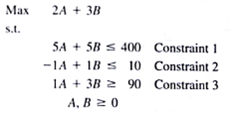
An Introduction to Management Science 13th Edition by David Anderson,Dennis Sweeney ,Thomas Williams ,Jeffrey Camm, Kipp Martin
النسخة 13الرقم المعياري الدولي: 978-1439043271
An Introduction to Management Science 13th Edition by David Anderson,Dennis Sweeney ,Thomas Williams ,Jeffrey Camm, Kipp Martin
النسخة 13الرقم المعياري الدولي: 978-1439043271 تمرين 26
Consider the following linear program: 
Figure 2.22 shows a graph of the constraint lines.
a. Place a number (1, 2, or 3) next to each constraint line to identify which constraint it represents.
b. Shade in the feasible region on the graph.
c. Identify the optimal extreme point. What is the optimal solution?
d. Which constraints are binding? Explain.
e. How much slack or surplus is associated with the nonbinding constraint?

Figure 2.22 shows a graph of the constraint lines.
a. Place a number (1, 2, or 3) next to each constraint line to identify which constraint it represents.
b. Shade in the feasible region on the graph.
c. Identify the optimal extreme point. What is the optimal solution?
d. Which constraints are binding? Explain.
e. How much slack or surplus is associated with the nonbinding constraint?
التوضيح
Linear programming:
Linear programming ...
An Introduction to Management Science 13th Edition by David Anderson,Dennis Sweeney ,Thomas Williams ,Jeffrey Camm, Kipp Martin
لماذا لم يعجبك هذا التمرين؟
أخرى 8 أحرف كحد أدنى و 255 حرفاً كحد أقصى
حرف 255








